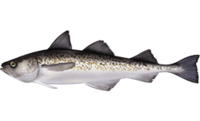
Photo from wikipedia
Abstract A marine heatwave caused the total biomass of Gulf of Alaska (GOA) Pacific cod to plummet by 67% from 2015 to 2018. Based on the results from GOA Pacific… Click to show full abstract
Abstract A marine heatwave caused the total biomass of Gulf of Alaska (GOA) Pacific cod to plummet by 67% from 2015 to 2018. Based on the results from GOA Pacific cod stock assessment model, the North Pacific Fishery Management Council cut the GOA Pacific cod total allowable catch (TAC) by 80% in 2018. This study uses a 10-region multi-regional social accounting matrix model to compute the economic impacts of the cod fishery disaster on the six borough and census areas (BCAs) in Southwest Alaska plus effects on the other four regions. We consider both the negative effects of the reduction in the cod harvest and the offsetting effects from an observed increase in the price of the fish to calculate the “net” economic impacts. This study found that the offsetting effects from the price increase are significant; the reduction in total regional output in the rest of the United States is 15% less severe if effects of the price changes are taken into account. Furthermore, the region suffering the largest impacts on total seafood industry output (Aleutians East Borough) from the reduced TAC is not necessarily the region where the largest total regional impact occurs (rest of the U.S.).
Journal Title: Ecological Economics
Year Published: 2021
Link to full text (if available)
Share on Social Media: Sign Up to like & get
recommendations!